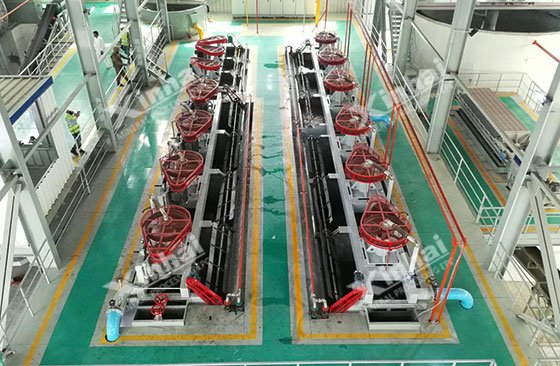What Are the Flotation Processes Used in the Extraction of Copper Lead Zinc Ore?
It is reported that more than 90% of non-ferrous metal ores (copper, lead, zinc, etc.) adopt flotation process, especially for those with fine grain and complex symbiosis. Flotation process can achieve ideal separation effect, and separately recover low-grade ore then enrich multiple high-grade concentrates. Different ore properties mean different flotation process. There are four kinds of flotation processes used in the extraction of copper lead zinc ore according to the dissemination characteristics of metal minerals.
1. Preferential flotation process used in the extraction of copper lead zinc ore
Process: According to the different flotability and floating speed among copper, lead, zinc ore, then separately obtains copper concentrate, lead concentrate and zinc concentrate from the slurry.
Application: Simple mineral composition, large differences in flotability among useful minerals, coarse disseminated grain size, high-graded raw ore.
Advantages: Adapt to the change of ore grade with high flexibility; save flotation reagent.
2. Bulk preferential flotation process used in the extraction of copper lead zinc ore
Process: Floats copper, lead and zinc minerals together in the mixed concentrate, and removes the reagents from the mixed concentrate and then separates, so that the copper, lead and zinc concentrate can be obtained.
Application: Useful minerals are unevenly embedded or associated with each other, or one useful mineral is finely embedded in another mineral, and its coarse coenobium is embedded in gangues.
Advantages: Good flotation effect; Improve the processing capacity per unit time; Avoid the overgrinding of dissociated useful minerals, which can reduce difficulty of later separation; Save production cost.

3. Partial mixture-differential flotation process used in the extraction of copper lead zinc ore
Process: Separates two useful minerals that with similar floatability into the mixed concentrate, and then floats each concentrate. That is, copper sulphide and lead ore with similar floatability are selected as mixed concentrate, and copper and lead is separated. Then the tailings were reactivated to separate the zinc concentrate.
Application: Copper lead zinc polymetallic sulfide ore with similar floatability.
Advantages: Process technology matures; easy to control the flotation conditions, combine the strengths of both differential flotation and bulk flotation, widely used in many plants.
4. Iso-flotability flotation process used in the extraction of copper lead zinc ore
Process: With the principle of "easiness to hardness", divides the recovered minerals into two parts: easy-to-float and difficult-to-float according to the difference of natural floatability, and then separate the copper, lead and zinc concentrate from the mixed concentrate.
Application: One of mineral has good floatability, while other minerals can be divided into easy-to-float and difficult-to-float.
Advantages: Reduce the reagent consumption, avoid the negative effect of excess reagent on flotation result, then improve the flotation indicator.

For the extraction of copper lead zinc ore, the key point is the lead-zinc separation, copper-zinc separation, copper-lead separation.
In general, the most difficulty of the polymetallic sulfide ores separation is the separation among several kinds of ores, especially those low-graded ores with complex embedded features. Therefore, it's a significant step for separating lead-zinc, copper-zinc, copper-lead to choose right flotation reagents. It is suggested to strictly implement the reagent system, control the dosage of reagent, reduce multiple circulation and loss, then strengthen the flotation effect.
1. Lead-Zinc Ore Separation: Differential flotation process, floats lead and depresses zinc.
Collectors: Low-level xanthate, advanced xanthate, aerofloat. Separation in alkaline medium.
Inhibitor: CN-、NaCN、kCN、ZnSO4、Na2OS3、Na2S2O3。
Activator: Copper sulfate,then collect with advanced xanthate.
2. Copper-zinc separation: Differential flotation process, floats copper and depresses zinc. If the separating difficulty is over 2, the depression on zinc should be strengthened.
Collectors: Low-level xanthate, advanced xanthate, aerofloat. Separation in alkaline medium.
Inhibitor: CN-、NaCN、kCN、ZnSO4、Na2OS3、Na2S2O3。
Activator: Copper sulfate,then collect with xanthate.
3. Copper-lead separation: Dereagent first, then differential flotation process. Floats copper and depresses lead, or floats lead and depresses copper.
• Floats copper and depresses lead: Widely used in secondary copper ore, Cu2+ ions are dissolved too much and bot easy to be inhibited.
• Floats lead and depresses copper: Widely used in primary copper ore.


评论
发表评论